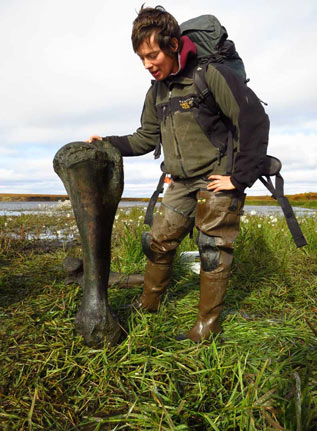
NPS Photo / Jonathan Hardes
Northwest Alaska Eighteen Thousand Years Ago
The Pleistocene, or mammoth, steppe was characterized by a dry climate, with cool summers and a landscape rich with grasses spanning from Spain to Canada. These conditions were ideal for the large grazers of the day, with the most common being the steppe bison (Bison priscus), horse (Equus sp.) and the woolly mammoth (Mammuthus primigenius) (Figure 2). Though much lower in numbers, a suite of carnivores that preyed upon the grazers also inhabited the region, with the American lion (Panthera atrox), short- faced bear (Arctodus simus), and the grey or timber wolf (Canis lupus) being the best known (Kurten and Anderson 1980). The area supported a much greater variety of species than we see today.
The Bering Land Bridge describes an arid swath of land that connected Asia with North America during the Pleistocene epoch (2,580,000 to 11,700 years ago). This connection occurred when massive ice sheets held a larger percentage of the earth’s water than today, causing sea levels to be lower, thereby exposing large tracts of land. At its greatest extent, approximately twenty-one thousand years ago, the land bridge measured some one thousand miles from north to south. The “bridge” served as a passageway for the movement of an array of species between the continents of Asia and North America.
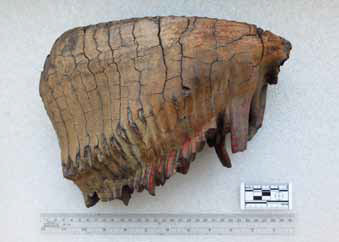
NPS Photo / Jeff Rasic
What Are Fossils?
A paleontological find or “fossil” in the strictest sense of the term refers to remains or other evidence of a once-living organism that have been preserved, carbonized or mineralized (petrified) through long-term exposure to mineral-rich groundwater. Essentially, some portion of the organism or a trace of its existence (such as a track or imprint) turns to stone over time, a process known as diagenesis.
However, scientists also frequently use the word fossil in a more ubiquitous way to describe specimens that are ten thousand years old or older. In other words, many bones found throughout Alaska, though described as fossils, have not actually petrified through the fossilization process. Fossils can include the remains of shells, plants, tracks, and feeding trails, and even the softer parts of animals such as feathers and skin.
Late Pleistocene fossils discovered in northwest Alaska consist primarily of remains of large mammals, whose more robust and denser teeth and bones lend themselves to better preservation and subsequent discovery than those of smaller species. Their greater size also makes them easier to spot on an open and vast landscape (Figure 1).
The most common local finds are the remains of the grazers, or those animals that subsisted primarily on grasses and sedges and tended to live in herds or larger extended family groups. It is important to note that many extant (still with us today) species, such as caribou, muskox, and brown bear lived alongside these now extinct fauna.
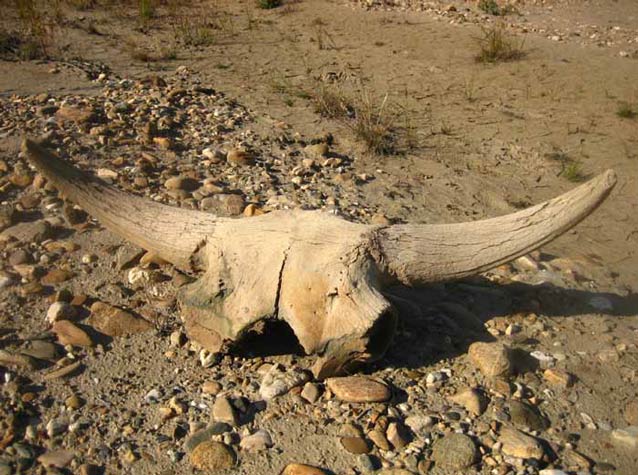
NPS Photo / Jeff Rasic
How Fossils End Up Where We Find Them
In order for ancient remains to preserve or fossilize, the organism or at least a portion of it must be buried soon after its death. Timely burial protects the bones from dispersal and destruction by scavengers as well as from the array of erosional forces constantly at work on the earth’s surface. Ideal conditions for preservation would also have an element of consistency; for example, the ground in which the remains are contained would remain wet or frozen with minimal fluctuation throughout the period of interment.
Many prehistoric remains found in northwest Alaska have found their way to the surface through the erosional forces of moving water. Along coastal areas, storm surges expose ancient fossils, often depositing them on beaches. The breakup of ice on rivers in the spring and the rising of water levels regularly erode away large portions of river bank, exposing fossils contained within. More often than not, the freshly exposed fossils are then washed down stream where they can accumulate on gravel bars (Figure 3). For this reason, area fossils found in their original locations are rare.
The Importance of In Situ Documentation
Paleontological resources provide scientists with a rare glimpse into the prehistoric past. Ancient environments and their various forms of plant and animal life can be reconstructed by studying these remains and the unique place in the landscapes in which they were discovered. These resources are incredibly limited in numbers and once they are damaged, or removed from their original locations (in situ), much of their educational and scientific data is lost.
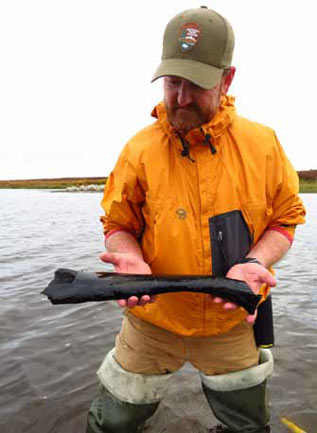
NPS Photo / Jonathan Hardes
Documentation of a find is often the most important aspect of fossil-related research and collection. Appropriate recording of a paleontological specimen includes information about the specimen (taxonomic identification, measurements, taphonomy), its location on the landscape (latitude/longitude, stratigraphic position), and the geology of the immediate area. Without this baseline data, the specimen has lost the vast majority of its potential to inform us about the prehistoric past (Figure 4).
A Heritage of Collecting and Current Management
Native inhabitants of Alaska have long used animal remains discovered on the landscape as sources of raw material for a variety of household items, hunting implements, and pieces of art. It is not unheard of for the remains of a five-hundred-year-old pit house in northwest Alaska to contain sections of a ten-thousand-year-old mammoth tusk. The ivory is likely collected from a nearby beach, taken to the home with portions put to use in myriad ways. This tradition of fossil collecting by Alaska Natives continues to the present with bones and ivory collected from Native- and privately-owned lands and put up for sale, either in their original form or after having been fashioned into objects of art. This common activity plays a critical role in the local subsistence, cash-based economy.
The National Park Service (NPS), charged with the stewardship of paleontological remains, seeks an ethical balance between the preservation of all prehistoric finds and the rights of long-term, Native inhabitants, whose very livelihoods (often for many generations) have involved the collection of these very remains.
Federal regulations are clear about not disturbing or damaging paleontological finds on federal lands. Appropriate management involves federal land-managing agencies conducting condition assessments leading to management actions that preserve paleontological resources where possible, or it permanently captures and documents the information these resources contain where preservation is not possible.
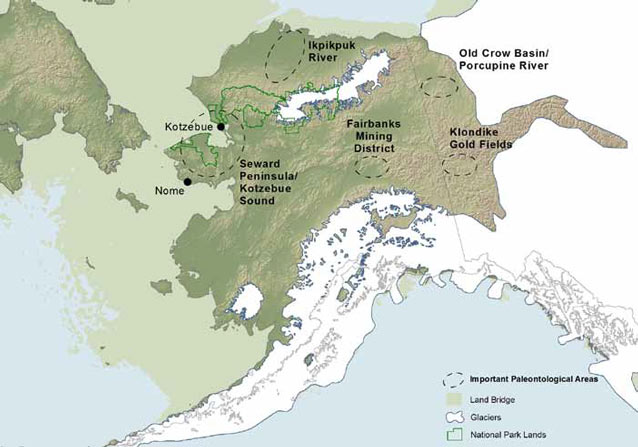
Courtesy Adam Freeburg
Paleontology and Northwest Alaska
Fossil remains are bountiful in northwest Alaska, with the Baldwin Peninsula, Kotzebue Sound, and Seward Peninsula being particularly fossil-rich areas (Figure 5). Recorded paleontological discoveries were made in the immediate area as early as 1816. However, the region has lacked the level of attention and scientific study of other northern areas such as the Klondike and the Yukon, and is therefore lesser known (Kurten 1980). In order for these resources to receive adequate protection and study, local avocational and scientific communities must become more aware of them and come together to share information. Scientists working in areas such as Kotzebue rely heavily on local knowledge to learn more about and protect paleontological resources. The author has found public workshops and blogging as well as a simple open-door policy for those who are already in possession of fossil remains, to be quite effective means of sharing this knowledge (Figure 6).
The Value of Fossils and Why We Study Them
Each fossil, no matter how fragmentary, is singular in its ability to illuminate the life of a particular creature and the age in which it lived. Fossils provide us with direct, tangible links to the prehistoric past, including long-extinct animal populations, changes in climate, and ecology. The study of past life forms even plays a role in modern conservation biology and wildlife management. Through the lens of paleontology and its vast spans of time, researchers are afforded an exceptional opportunity to look at long-term biological trends and apply their findings to prevailing conservation concerns. Of course in order to study the prehistoric past, we must protect and conserve the remnants of it. For federal managers, the Paleontological Resources Preservation Act (PRPA) provides the authority for the preservation and management of ancient remains. The act also reminds us that collecting these resources from federal lands without the appropriate permits is not permitted. In fact, damage or removal of paleontological resources can lead to conviction and a felony charge. State, federal, and Alaska Native Corporation land managers each have their own set of rules designed to protect these resources.
Suggestions for the Discovery of a New Find
- Please do not touch, move, collect, or otherwise disturb artifacts, cultural features, or paleontological resources.
- Record the site location with a GPS unit or by marking it on a topographic map with compass bearings to prominent landmarks.
- Provide a detailed description of approximate size, numbers, and position of materials.
- If you have a camera, please take photographs of the site area and surrounding landscape. If possible, include a scale in photos of individual items or specimens.
- Report information to an archeologist or paleontologist.
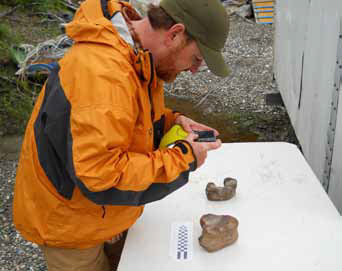
NPS Photo / Jonathan Hardes
For More Information
- Society of Vertebrate Paleontology
- The Paleontological Society Code of Fossil Collecting
- Paleontology in the National Parks
- Ice Age Mammal Bones of Northwest Alaska blog series
Acknowledgements
Employment with the National Park Service and specifically the Western Arctic National Parklands (Bering Land Bridge National Preserve, Cape Krusenstern National Monument, Kobuk Valley National Park, and Noatak National Preserve) provides the author with an incredibly unique opportunity to work and live in the heart of Beringia. Jeff Rasic of Yukon-Charley National Preserve and Gates of the Arctic National Park and Preserve deserves a special thank you for his thoughtful and timely comments as well as his longstanding support for cultural and natural resources in the region. Gratitude also goes out to the residents of Kotzebue and its satellite villages for their willingness to share knowledge of fossil finds with an outsider. Thank you.
References
Dyke, A. 2004.
An outline of North American Deglaciation with emphasis on central and northern Canada. Quaternary Glaciations-Extent and Chronology, Part II, p. 373-424, J. Ehlers, and P. Gibbard, eds. Elsevier.
Elias, S. 1995.
The Ice-Age History of Alaska National Parks. Washington: Smithsonian Institutional Press.
Guthrie, R. 1990
Frozen Fauna of the Mammoth Steppe: The Story of Blue Babe. Chicago: University of Chicago Press.
Hopkins, D. 1967.
The Bering Land Bridge. Redwood City, CA: Stanford University Press.
Kurten, B., and E. Anderson. 1980.
Pleistocene Mammals of North America. New York: Columbia University Press.
Manley, W., 2002.
Postglacial Flooding of the Bering Land Bridge: A Geospatial Animation: Institute of Arctic and Alpine Research, University of Colorado, v1, http://instaar.colorado.edu/QGISL/bering_land_bridge
Manley, W., and D. Kaufman. 2002.
Alaska PaleoGlacier Atlas: Institute of Arctic and Alpine Research, University of Colorado, http://instaar.colorado.edu/QGISL/ak_paleoglacier_atlas, v. 1
Shapiro, B., et al. 2004.
Rise and Fall of the Beringian Steppe Bison. Science.
Turner, Alan and Mauricio Anton. 1997.
The Big Cats and their fossil relatives. New York: Columbia University Press.
Zimov, S.A., et al. 2012.
Mammoth steppe: A high-productivity phenomenon. Quaternary Science Reviews.
Part of a series of articles titled Alaska Park Science - Volume 13 Issue 1: Wilderness in Alaska.
Last updated: October 26, 2021
